“Justice is a machine that, when someone has once given it the starting push, rolls on of itself.”
John Galsworthy, Justice
Terry Teachout on the arts in New York City
“Justice is a machine that, when someone has once given it the starting push, rolls on of itself.”
John Galsworthy, Justice
Various forms of the records-that-changed-my-life meme have been making the rounds lately, so I came up with my own version, which I call “The Twenty-Five Record Albums That Changed My Life.” Throughout the coming month, I’ll write about one of these albums each weekday in the rough order in which I first heard them.
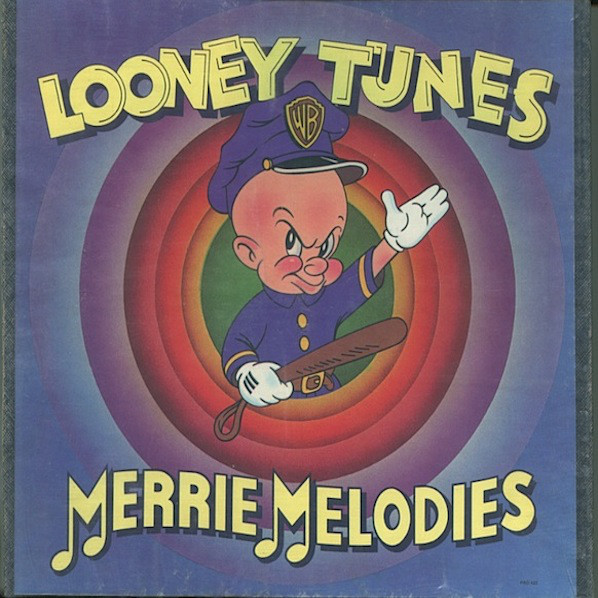
The passage I have in mind has to do with the now-forgotten Warner/Reprise “Loss Leader” albums, a series of low-priced sampler albums by Warner/Reprise artists that was one of the most ingenious and effective promotional ideas ever to be devised by a major record label. It certainly caught my eye, with far-reaching results:
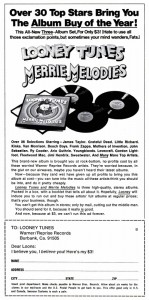
To be a teenage boy…is to long above all things to appreciate the music of your own time. For me that was rock and roll, and notwithstanding the unhelpfulness of the local radio stations, there were plenty of other ways to learn about it, including Looney Tunes & Merrie Melodies, one of the “Loss Leader” samplers that Warner Bros. sold by mail for a dollar a disc.
I saw an ad for Looney Tunes & Merrie Melodies in Stereo Review in 1971, sent off three crumpled one-dollar bills ($17 today), and a few weeks later found myself in possession of a three-LP box set containing thirty-three songs by the very wide-ranging likes of Black Sabbath, Captain Beefheart, Ry Cooder, the Faces, Fleetwood Mac, Jimi Hendrix, Gordon Lightfoot, the Grateful Dead, the Kinks, Little Feat, Little Richard, Van Morrison, Randy Newman, Van Dyke Parks, James Taylor, Jimmy Webb, the Youngbloods, Frank Zappa and the Mothers of Invention, and a British group called, believe it or not, Hard Meat. (They were actually pretty good.)
Some I loved, some I loathed, a few I didn’t quite get, but none of it mattered: I soaked them all up with indiscriminate avidity….
Sad to say, Warner Bros. never released compact-disc versions of any of its Loss Leader sets. By then, though, I owned most of the albums from which my favorite cuts on Looney Tunes & Merrie Melodies were drawn, though it wasn’t until fairly recently that I caught up at last with Ry Cooder, whose “Alimony” sounds as piquant to me now as it did then. In the process of deciding which ones to buy, I was making the acquaintance of an extraordinarily diverse assortment of early-Seventies pop-music styles, many of which continue to speak to me a half-century later, which was just what the folks at Warner Bros. had in mind.
And did my youthful musical experimentation have any permanent consequences? Well, “Alimony” is one of seven tracks on Looney Tunes & Merrie Melodies to which I continue to listen today, the others being the Kinks’ “Apeman,” Randy Newman’s “Let’s Burn Down the Cornfield,” Hard Meat’s “Smile as You Go Under,” Jimi Hendrix’ “Stepping Stone,” Little Feat’s “Strawberry Flats,” and Fleetwood Mac’s “Tell Me All the Things You Do.” Seven out of thirty-three: as pop music goes, I’d say that’s a pretty good batting average.
(To be continued)
* * *
“Alimony,” from Ry Cooder’s self-titled debut album, released in 1970:
“Strawberry Flats,” from Little Feat’s self-titled debut album, released in 1971:
* * *
To read about album #1, go here.
To read about album #2, go here.
To read about album #3, go here.
To read about album #4, go here.
To read about album #5, go here.
To read about album #6, go here.
To read about album #7, go here.
To read about album #8, go here.
To read about album #9, go here.
To read about album #10, go here.
To read about album #11, go here.
To read about album #12, go here.
To read about album #13, go here.
To read about album #14, go here.
To read about album #15, go here.
To read about album #16, go here.
The Platters perform on The Perry Como Show. This episode was originally telecast by NBC on February 18, 1956:
(This is the latest in a series of arts- and history-related videos that appear in this space each Monday, Wednesday, and Friday)
“Dear God, don’t take Adrian away from me. This is the man I’ve been drawing strength from since I was eleven years old. Never a vigorous man. Not a brilliant man. Not a man whose passing will be noted far and wide. But steady. Trusting. Self-satisfied without being self-absorbed. Devout. Good-natured. Undemanding. Even-tempered. Loving. Holy.”
Jon Hassler, North of Hope
Various forms of the records-that-changed-my-life meme have been making the rounds lately, so I came up with my own version, which I call “The Twenty-Five Record Albums That Changed My Life.” For the next couple of weeks, I’ll be writing about one of these albums every weekday in the approximate order in which I first heard them.
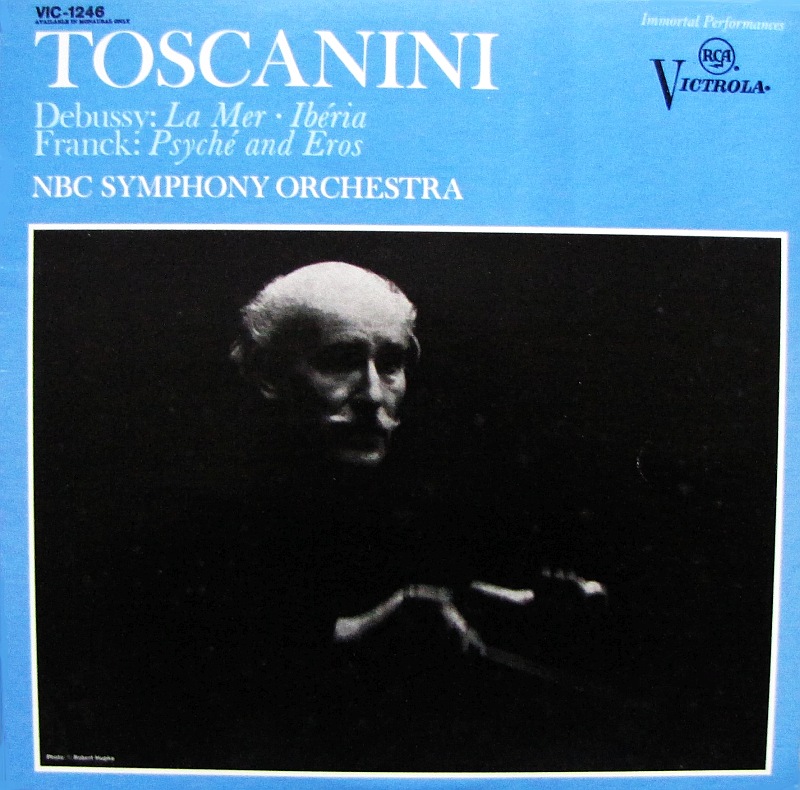
A Wal-Mart, the first one outside Arkansas, opened in 1968 in Smalltown, U.S.A.. It was located a mile from my front door, an easy ride via bicycle, and it sported a good-sized record section, most of which was devoted to pop and country music—but not all.
Three bins were reserved for classical albums, many of them new releases from Victrola, RCA’s budget-priced classical line. They sold for $2.98 apiece, slightly less than twenty dollars in today’s money. I’d pretty much exhausted the classical stock at Collins Piano Company, and the only place from which it was then possible to order records by mail was the Columbia Record Club. Even though I was increasingly obsessed with rock and roll, I still loved classical music, and I’d acquired a fair-sized stack of Victrolas by the time I left for college.
Victrola was a reissue line, many of whose releases dated from the 78 era, the golden age of classical recording. For me that meant, first and foremost, Arturo Toscanini and the NBC Symphony. I’d read about Toscanini in B.H. Haggin’s New Listener’s Companion and Record Guide, in which he was described as the greatest of all orchestral conductors. Such categorical statements invariably excite young readers, so I went out and started buying Toscanini albums, all of whose simply but elegantly designed covers featured Robert Hupka’s dramatic black-and-white photos of the Maestro at work. The sound was a bit variable, but the performances were thrilling without exception, and I got to know most of the standard orchestral repertoire from Toscanini’s lean, intense interpretations.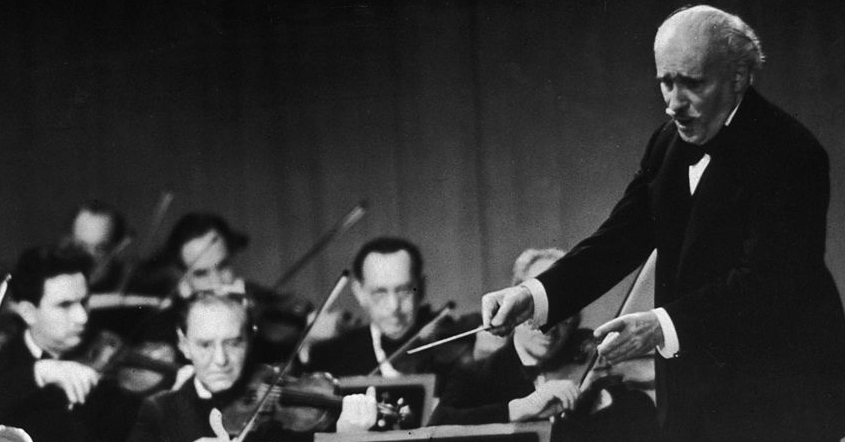
Be that as it may, I owe B.H. Haggin an immeasurable debt of gratitude, not merely for getting me into High Fidelity but for introducing me to Arturo Toscanini, Artur Schnabel, Joseph Szigeti, and other legendary musicians of the past whose faded, scratchy recordings I treasure to this day. And I owe a similar debt to Wal-Mart, without which my high-school record collection would have been much smaller and far less interesting.
(To be continued)
* * *
Arturo Toscanini and the NBC Symphony perform “Jeux de vagues,” the second movement of La Mer, in 1950:
Two concerts by Toscanini and the NBC Symphony, originally telecast live from Carnegie Hall on March 15 and 22, 1952. The programs include an excerpt from Franck’s Rédemption, Sibelius’ En Saga, two of Debussy’s Nocturnes, Rossini’s William Tell Overture, Beethoven’s Fifth Symphony, and Respighi’s Pines of Rome:
Toscanini rehearses the NBC Symphony in the first movement of La Mer at Carnegie Hall in February of 1953:
* * *
To read about album #1, go here.
To read about album #2, go here.
To read about album #3, go here.
To read about album #4, go here.
To read about album #5, go here.
To read about album #6, go here.
To read about album #7, go here.
To read about album #8, go here.
To read about album #9, go here.
To read about album #10, go here.
To read about album #11, go here.
To read about album #12, go here.
To read about album #13, go here.
To read about album #14, go here.
To read about album #15, go here.
“She watched his eyes. Why is it that some people display themselves in their eyes, she wondered, while others do not? Her own eyes, she well knew, usually displayed only what she wanted them to, while people like Frank seemed unable to dissemble, unable to hide even the most fleeting thought. You couldn’t help trusting eyes like that.”
Jon Hassler, North of Hope
From 2009:
Read the whole thing here.Harcourt sent me the first finished copy of Pops: A Life of Louis Armstrong last Tuesday. It was an inordinately busy week crammed full of shows and deadlines, but I talked a sympathetic editor into giving me the rest of the day off and spent the afternoon and evening rereading the book. I spent a certain amount of time admiring the index, snuffling for typos—in vain, I’m glad to report—and confirming that the corrections I made on the galley proofs were incorporated into the final version. Mostly, though, I just flipped through the pages of Pops and marveled at how good it looked….
Various forms of the records-that-changed-my-life meme have been making the rounds lately, so I came up with my own version, which I call “The Twenty-Five Record Albums That Changed My Life.” Throughout the coming month, I’ll write about one of these albums each weekday in the rough order in which I first heard them.
15. Leonid Kogan with Kiril Kondrashin and the Philharmonia Orchestra, Brahms D Major Violin Concerto, Op. 77 (Seraphim)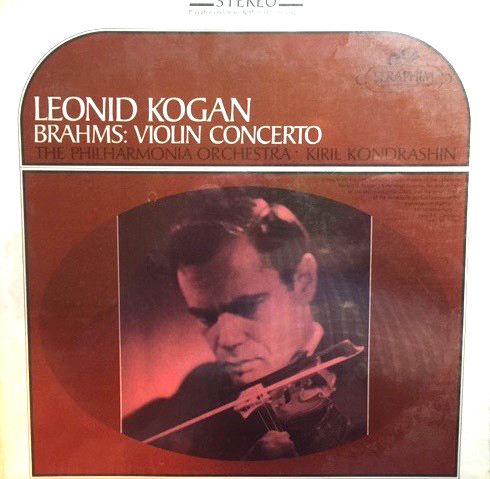
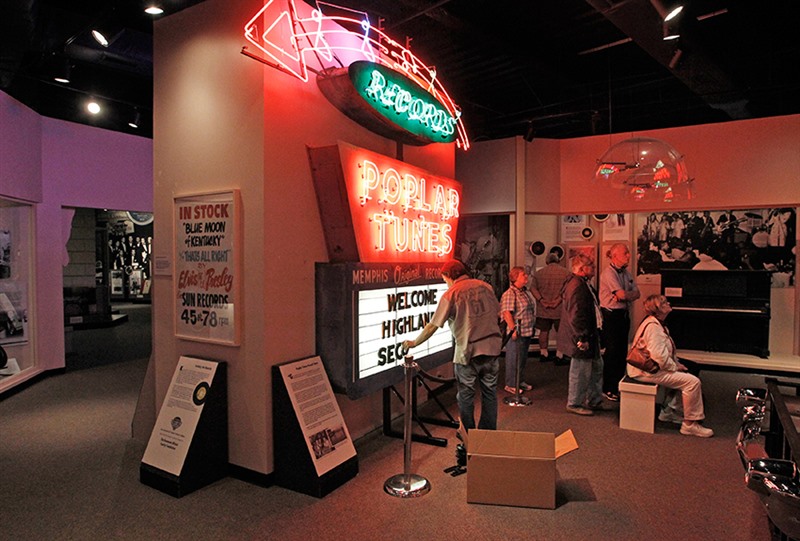
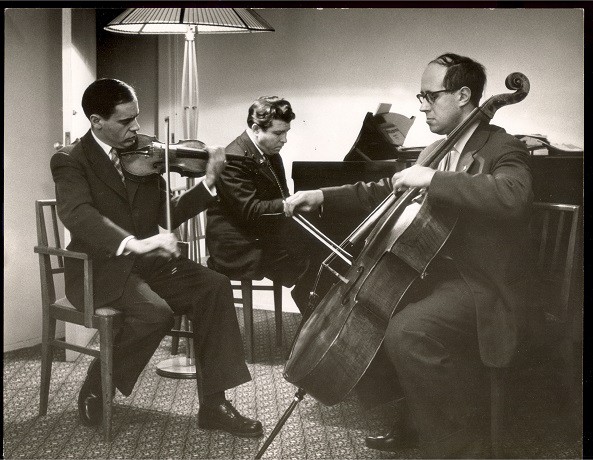
Brahms has always been one of the classical composers who means the most to me. My love for his music started here.
(To be continued)
* * *
Leonid Kogan, Kiril Kondrashin, and the Philharmonia Orchestra perform the Brahms Violin Concerto in 1958:
* * *
To read about album #1, go here.
To read about album #2, go here.
To read about album #3, go here.
To read about album #4, go here.
To read about album #5, go here.
To read about album #6, go here.
To read about album #7, go here.
To read about album #8, go here.
To read about album #9, go here.
To read about album #10, go here.
To read about album #11, go here.
To read about album #12, go here.
To read about album #13, go here.
To read about album #14, go here.
| M | T | W | T | F | S | S |
|---|---|---|---|---|---|---|
| 1 | 2 | 3 | 4 | 5 | ||
| 6 | 7 | 8 | 9 | 10 | 11 | 12 |
| 13 | 14 | 15 | 16 | 17 | 18 | 19 |
| 20 | 21 | 22 | 23 | 24 | 25 | 26 |
| 27 | 28 | 29 | 30 | 31 | ||
An ArtsJournal Blog